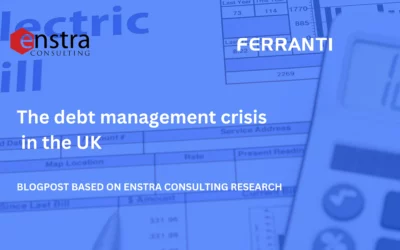Electricity and gas prices are rising. Advance bills of 1,000 euros a month are sought from customers, to continue to afford day-to-day living expenses. Money that not just anyone can spare on a monthly basis, despite the fact that heating is a basic necessity.
Not only is this a tough issue for end consumers, but suppliers face a challenge here too. After all, what if the majority of your customers, can no longer pay your invoice?

Reasons why electricity and gas are so expensive nowadays
1. Purchase of gas reserves in 2020/2021
Every year, suppliers have to estimate how much gas is going to be needed to keep all families warm in winter. The parameters here are the duration and the intensity of the winter. The longer and colder it is, the more reserves they need to purchase. Not easy to forecast in advance, as it turned out in the winter of 2020-2021.
The winter of 2020/2021 in Belgium and the Netherlands was harsher than predicted in advance, and it also took a long time for spring to really arrive. While gas reserves are normally replenished in spring, stocks were only decreasing in early 2021. Fearing another such harsh winter, reserves were replenished at an accelerated pace during 2021, resulting in high demand.
Source: https://www.anwb.nl/huis/energie/waarom-zijn-stroom-en-gas-nu-zo-duur
2. War between Russia and Ukraine
Russia has been at war with Ukraine since February this year. As many innocent civilians are victims of this, the EU decided to impose sanctions on Russia. To counter pressure, Russia, the biggest gas supplier to the EU decided to supply limited/no more gas. This creates a lot of uncertainty about the supply of gas and oil, causing prices to keep rising.
Source: https://www.bbc.com/news/world-europe-60131520
3. Gas determining the electricity prices in Belgium and the Netherlands
Electricity can be generated in different ways. Think of coal, gas, biomass, sun and wind or nuclear power. The price of electricity is determined by the most expensive component in the above-mentioned generation mix, and this currently gas.
Because gas power plants are so expensive to run, the European electricity market decided 20 years ago that the last bit of electricity needed and generated by gas power plants will therefore also determine the price of electricity. This is to protect the owners of gas power plants.
Source: https://www.anwb.nl/huis/energie/waarom-zijn-stroom-en-gas-nu-zo-duur
How you can help as a supplier
Leaving your clients literally and figuratively out in the cold is not an option. Counting on government mediation usually takes a long time or is negligible. Taking matters into your own hands as a supplier is therefore the best solution.
You can do so by visiting people’s homes to create a personalized, financially viable plan that ensures they can still spend the winter warm. Your customers will not easily forget the gesture you make as a supplier. Helping each other in times of need is not always obvious, whereas it should be. By looking for a solution together, the loyalty of your customers will only grow, which will become indispensable in this rapidly evolving energy market.
Tools and technologies that can help you in this journey
It is and remains important that your customers are able to pay their invoices optimally. Because no matter how you look at it, managing a good cash flow as a supplier is essential. Especially in this current context when bad debt and debt management costs have become a very significant element of Energy Retailers “cost to serve”. A state-of-the-art ERP system that helps you optimise the management of debt collection and financial support provision to minimise the impacts of debt on business performance plays a key role here.
When looking at the day-to-day operations of suppliers, there are two ways in which they can support their customers in this process:
- By preventing debts
- By recovering debts
Preventing debts
Preventively alerting and informing customers remains tremendously important. This means having the ability to forecast debt problems before they arise. Important here is also the ability to identify consumers who genuinely “can’t pay” because of financial hardship and those who choose not to pay for another reason – the “wont pays”.
1. Prevention by credit checking at customer acquisition
As any company wants to keep a healthy financial performance, doing a credit check before formally on-boarding a new customer can be an effective strategy to avoid ending with ‘won’t pays’ debt problems. This can be done by integrating a health check with public data from credit reference agencies, where you can gain valuable insights on how the prospect has fared to date.
These insights can then be used to tailor your offerings and provide support to your customer during these turbulent times. For instance, understanding which customers would benefit from prepayment services or conversion to direct debit payment methods. This health check step can easily be added in the MECOMS 365 orchestrated flows when moving in customers to your portfolio so it gets automated in the standard process.
2. Prevention by managing payment behaviour
Assigning each customer a classification, can provide insight to the company service agents to give tailored messages, services and offers and hence improve the cost-2-serve. This customer classification functionality is based on a score point system tailored to the company objectives and displayed on the 360° customer view with the categories such as: good, medium or bad.
While the main influencer of this scoring are events linked to the payment & debt behaviour of the customer, this information can be useful to prevent recurrent customers falling into bad debt.

3. Adding one step before the dunning cycle
Even when an invoice is already out the door, actions can be taken to ensure that customers, identified as risk payers in the customer classification, can fulfil it. If a customer does not pay the invoice on time, the dunning cycle process will start, where reminder letters can be sent to avoid having to reach court actions or applied penalties (depending on each company’s policy or legislation).
Important to know is, that there is a window of opportunity between the invoice and the due date:

For example, when sending an invoice, a supplier can mention what options customers have in case they cannot pay the invoice, for instance the options they have to access support schemes or social tariff depending on the country’s specific policies. Also, an interim reminder of their payment options, between sending the invoice and the due date can help.
Recovering debts
With rising prices, well-paying customers may also face unexpected bills. Therefore, having a well-defined approach as a supplier when this occurs, will ensure that your customers can keep their heads above water.
1. Engaging consumers via the most appropriate communication channel
Engaging customers via Omni-channel capabilities that can be varied in line with the debt life cycle. At MECOMS we provide several tools to segment your customers based on different demographics, profile criteria or even the customer classification scoring. This, together with MECOMS 365 customer service dashboards to help service agents proactively collect debt dependent on customer individual circumstances, can improve the customer relationship in these difficult times.
2. Creating a tailor made payment plan
When a customer is in debt, you as a supplier can lend a hand by creating a personal and achievable payment plan. This plan can be proposed via the most appropriate communication channel explained above.
Although, there is nothing more personal than an employee visiting a customer to sit down together and look at options. To make this possible, suppliers will need to empower their field service agents with an application in which they can set up tailored payment plans.
The MECOMS 365 field customer service app provides a mobile application that enables the customer agents to carry out on site visits to customers with real-time information coming directly from your finance system.
Not only can payment plans be created, the agents will also have the possibility to enter any specific question the customer might have by creating a case or enter a meter read for the customer on the spot.
Eager to discover how MECOMS 365 can help you and your customers in this challenges?
Then we are happy to demo all the possibilities! Fill in the form below and receive an answer within 2 working days.
Or want to have a chat on debt & collections?
Then come and visit our experts at the following events:
Future of Utilities Summit
21-22 November 2022 | Business Design Centre | London



